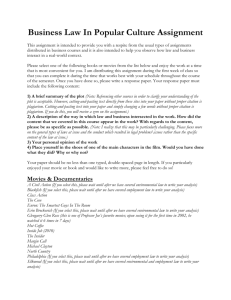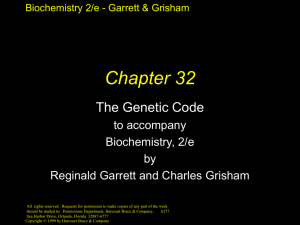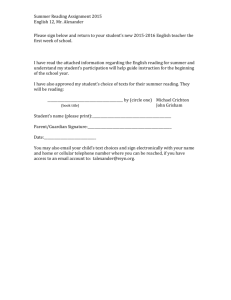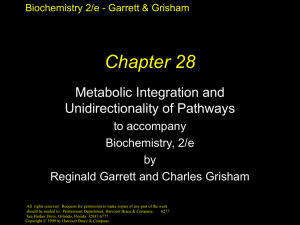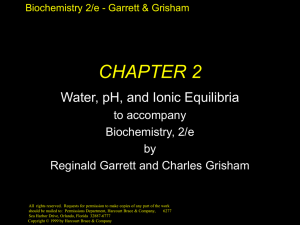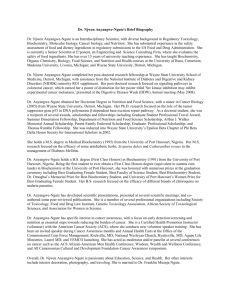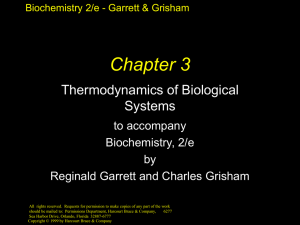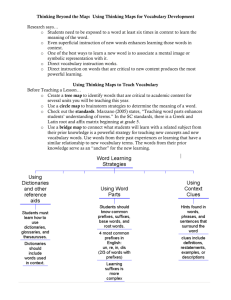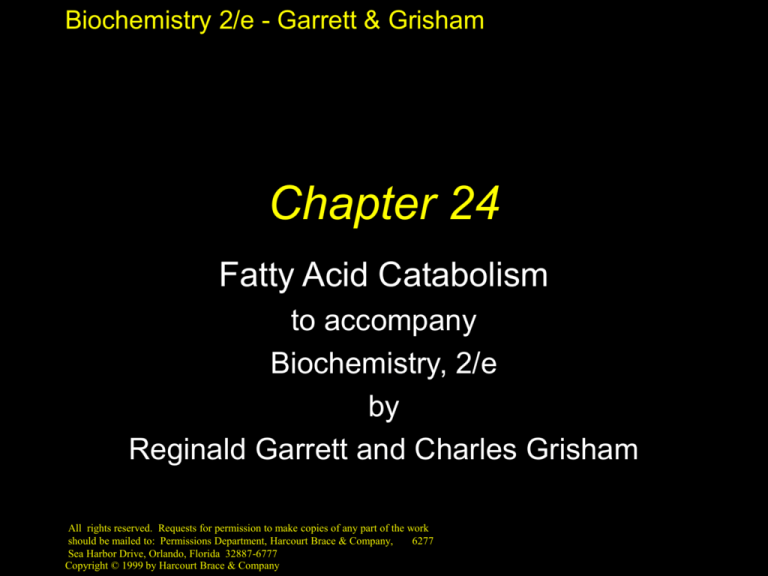
Biochemistry 2/e - Garrett & Grisham
Chapter 24
Fatty Acid Catabolism
to accompany
Biochemistry, 2/e
by
Reginald Garrett and Charles Grisham
All rights reserved. Requests for permission to make copies of any part of the work
should be mailed to: Permissions Department, Harcourt Brace & Company,
6277
Sea Harbor Drive, Orlando, Florida 32887-6777
Copyright © 1999 by Harcourt Brace & Company
Biochemistry 2/e - Garrett & Grisham
Outline
• 24.1 Mobilization of Fats from Dietary
Intake and Adipose Tissue
• 24.2 Beta-Oxidation of Fatty Acids
• 24.3 Odd-Carbon Fatty Acids
• 24.4 Unsaturated Fatty Acids
• 24.5 Other Aspects of Fatty Acid
Oxidation
• 24.6 Ketone Bodies
Copyright © 1999 by Harcourt Brace & Company
Biochemistry 2/e - Garrett & Grisham
Why Fatty Acids?
(For energy storage?)
• Two reasons:
– The carbon in fatty acids (mostly CH2) is
almost completely reduced (so its oxidation
yields the most energy possible).
– Fatty acids are not hydrated (as mono- and
polysaccharides are), so they can pack
more closely in storage tissues
Copyright © 1999 by Harcourt Brace & Company
Biochemistry 2/e - Garrett & Grisham
Fat from Diet & Adipose Cells
•
•
•
•
Triacylglycerols either way
Triglycerides represent the major energy input in
the modern American diet (but it wasn't always
this way)
Triglycerides are also the major form of stored
energy in the body
See Table 24.1
Hormones (glucagon, epinephrine, ACTH)
trigger the release of fatty acids from adipose
tissue
Copyright © 1999 by Harcourt Brace & Company
Biochemistry 2/e - Garrett & Grisham
Copyright © 1999 by Harcourt Brace & Company
Biochemistry 2/e - Garrett & Grisham
Copyright © 1999 by Harcourt Brace & Company
Biochemistry 2/e - Garrett & Grisham
Copyright © 1999 by Harcourt Brace & Company
Biochemistry 2/e - Garrett & Grisham
Beta Oxidation of Fatty Acids
Knoop showed that fatty acids must be degraded
by removal of 2-C units
• Albert Lehninger showed that this occurred in
the mitochondria
• F. Lynen and E. Reichart showed that the 2-C
unit released is acetyl-CoA, not free acetate
• The process begins with oxidation of the
carbon that is "beta" to the carboxyl carbon, so
the process is called"beta-oxidation"
Copyright © 1999 by Harcourt Brace & Company
Biochemistry 2/e - Garrett & Grisham
Copyright © 1999 by Harcourt Brace & Company
Biochemistry 2/e - Garrett & Grisham
Copyright © 1999 by Harcourt Brace & Company
Biochemistry 2/e - Garrett & Grisham
CoA activates FAs for oxidation
•
•
•
•
Acyl-CoA synthetase condenses fatty acids with
CoA, with simultaneous hydrolysis of ATP to AMP
and PPi
Formation of a CoA ester is expensive
energetically
Reaction just barely breaks even with ATP
hydrolysis
But subsequent hydrolysis of PPi drives the
reaction strongly forward
Note the acyl-adenylate intermediate in the
mechanism!
Copyright © 1999 by Harcourt Brace & Company
Biochemistry 2/e - Garrett & Grisham
Copyright © 1999 by Harcourt Brace & Company
Biochemistry 2/e - Garrett & Grisham
Copyright © 1999 by Harcourt Brace & Company
Biochemistry 2/e - Garrett & Grisham
Carnitine as a Carrier
•
•
•
•
Carnitine carries fatty acyl groups across the
inner mitochondrial membrane
Short chain fatty acids are carried directly into
the mitochondrial matrix
Long-chain fatty acids cannot be directly
transported into the matrix
Long-chain FAs are converted to acyl
carnitines and are then transported in the cell
Acyl-CoA esters are formed inside the inner
membrane in this way
Copyright © 1999 by Harcourt Brace & Company
Biochemistry 2/e - Garrett & Grisham
Copyright © 1999 by Harcourt Brace & Company
Biochemistry 2/e - Garrett & Grisham
-Oxidation of Fatty Acids
•
•
•
•
A Repeated Sequence of 4 Reactions
Strategy: create a carbonyl group on the -C
First 3 reactions do that; fourth cleaves the
"-keto ester" in a reverse Claisen
condensation
Products: an acetyl-CoA and a fatty acid two
carbons shorter
The first three reactions are crucial and classic we will see them again and again in other
pathways
Copyright © 1999 by Harcourt Brace & Company
Biochemistry 2/e - Garrett & Grisham
Copyright © 1999 by Harcourt Brace & Company
Biochemistry 2/e - Garrett & Grisham
Acyl-CoA Dehydrogenase
•
•
•
•
Oxidation of the C-C bond
A family of three soluble matrix enzymes
Mechanism involves proton abstraction,
followed by double bond formation and
hydride removal by FAD
Electrons are passed to an electron transfer
flavoprotein, and then to the electron
transport chain
Enzyme is inhibited by a metabolite of
hypoglycin (from akee fruit)
Copyright © 1999 by Harcourt Brace & Company
Biochemistry 2/e - Garrett & Grisham
Copyright © 1999 by Harcourt Brace & Company
Biochemistry 2/e - Garrett & Grisham
Copyright © 1999 by Harcourt Brace & Company
Biochemistry 2/e - Garrett & Grisham
Copyright © 1999 by Harcourt Brace & Company
Biochemistry 2/e - Garrett & Grisham
Copyright © 1999 by Harcourt Brace & Company
Biochemistry 2/e - Garrett & Grisham
Enoyl-CoA Hydratase
Adds water across the double bond
• at least three forms of the enzyme are
known
• aka crotonases
• Normal reaction converts trans-enoylCoA to L--hydroxyacyl-CoA
Copyright © 1999 by Harcourt Brace & Company
Biochemistry 2/e - Garrett & Grisham
Hydroxyacyl-CoA
Dehydrogenase
Oxidizes the -Hydroxyl Group
• This enzyme is completely specific for
L-hydroxyacyl-CoA
• D-hydroxylacyl-isomers are handled
differently
Copyright © 1999 by Harcourt Brace & Company
Biochemistry 2/e - Garrett & Grisham
Copyright © 1999 by Harcourt Brace & Company
Biochemistry 2/e - Garrett & Grisham
Fourth reaction: thiolase
•
•
•
•
aka -ketothiolase
Cysteine thiolate on enzyme attacks the carbonyl group
Thiol group of a new CoA attacks the shortened
chain, forming a new, shorter acyl-CoA
This is the reverse of a Claisen condensation:
attack of the enolate of acetyl-CoA on a thioester
Even though it forms a new thioester, the reaction
is favorable and drives other three
Copyright © 1999 by Harcourt Brace & Company
Biochemistry 2/e - Garrett & Grisham
Copyright © 1999 by Harcourt Brace & Company
Biochemistry 2/e - Garrett & Grisham
Summary of -Oxidation
•
•
•
•
Repetition of the cycle yields a succession of
acetate units
Thus, palmitic acid yields eight acetyl-CoAs
Complete -oxidation of one palmitic acid yields
106 molecules of ATP
Large energy yield is consequence of the highly
reduced state of the carbon in fatty acids
This makes fatty acids the fuel of choice for
migratory birds and many other animals
Copyright © 1999 by Harcourt Brace & Company
Biochemistry 2/e - Garrett & Grisham
Odd-Carbon Fatty Acids
-Oxidation yields propionyl-CoA
• Odd-carbon fatty acids are metabolized
normally, until the last three-C fragment propionyl-CoA - is reached
• Three reactions convert propionyl-CoA to
succinyl-CoA
• Note the involvement of biotin and B12
• Note the calculation of catalytic power of the
epimerase reaction
• Note pathway for net oxidation of succinyl-CoA
Copyright © 1999 by Harcourt Brace & Company
Biochemistry 2/e - Garrett & Grisham
Copyright © 1999 by Harcourt Brace & Company
Biochemistry 2/e - Garrett & Grisham
Copyright © 1999 by Harcourt Brace & Company
Biochemistry 2/e - Garrett & Grisham
Copyright © 1999 by Harcourt Brace & Company
Biochemistry 2/e - Garrett & Grisham
Copyright © 1999 by Harcourt Brace & Company
Biochemistry 2/e - Garrett & Grisham
Unsaturated Fatty Acids
Consider monounsaturated fatty acids:
• Oleic acid, palmitoleic acid
• Normal -oxidation for three cycles
• cis-3 acyl-CoA cannot be utilized by
acyl-CoA dehydrogenase
• Enoyl-CoA isomerase converts this to
trans- 2 acyl CoA
-oxidation continues from this point
Copyright © 1999 by Harcourt Brace & Company
Biochemistry 2/e - Garrett & Grisham
Copyright © 1999 by Harcourt Brace & Company
Biochemistry 2/e - Garrett & Grisham
Polyunsaturated Fatty Acids
Slightly more complicated
• Same as for oleic acid, but only up to a
point:
– 3 cycles of -oxidation
– enoyl-CoA isomerase
– 1 more round of -oxidation
– trans- 2, cis- 4 structure is a problem!
• 2,4-Dienoyl-CoA reductase to the
rescue!
Copyright © 1999 by Harcourt Brace & Company
Biochemistry 2/e - Garrett & Grisham
Copyright © 1999 by Harcourt Brace & Company
Biochemistry 2/e - Garrett & Grisham
Peroxisomal -Oxidation
Peroxisomes - organelles that carry out flavindependent oxidations, regenerating oxidized
flavins by reaction with O2 to produce H2O2
• Similar to mitochondrial -oxidation, but initial
double bond formation is by acyl-CoA
oxidase
• Electrons go to O2 rather than e- transport
• Fewer ATPs result
Copyright © 1999 by Harcourt Brace & Company
Biochemistry 2/e - Garrett & Grisham
Copyright © 1999 by Harcourt Brace & Company
Biochemistry 2/e - Garrett & Grisham
Branched-Chain Fatty Acids
An alternative to -oxidation is required
• Branched chain FAs with branches at
odd-number carbons are not good
substrates for -oxidation
-oxidation is an alternative
• Phytanic acid -oxidase decarboxylates
with oxidation at the alpha position
-oxidation occurs past the branch
Copyright © 1999 by Harcourt Brace & Company
Biochemistry 2/e - Garrett & Grisham
Copyright © 1999 by Harcourt Brace & Company
Biochemistry 2/e - Garrett & Grisham
Ketone Bodies
•
•
•
•
•
•
A special source of fuel and energy for certain
tissues
Some of the acetyl-CoA produced by fatty acid
oxidation in liver mitochondria is converted to
acetone, acetoacetate and -hydroxybutyrate
These are called "ketone bodies"
Source of fuel for brain, heart and muscle
Major energy source for brain during starvation
Synthesis in Figure 24.28
They are transportable forms of fatty acids!
Copyright © 1999 by Harcourt Brace & Company
Biochemistry 2/e - Garrett & Grisham
Copyright © 1999 by Harcourt Brace & Company
Biochemistry 2/e - Garrett & Grisham
Ketone Bodies - II
•
•
•
•
•
Interesting Aspects of Their Synthesis
Occurs only in the mitochondrial matrix
First step - Figure 24.28 - is reverse thiolase
Second reaction makes HMG-CoA
These reactions are mitochondrial
analogues of the (cytosolic) first two steps
of cholesterol synthesis
Third step - HMG-CoA lyase - is similar to
the reverse of citrate synthase
Copyright © 1999 by Harcourt Brace & Company
Biochemistry 2/e - Garrett & Grisham
Ketone Bodies and Diabetes
•
•
•
•
"Starvation of cells in the midst of plenty"
Glucose is abundant in blood, but uptake by
cells in muscle, liver, and adipose cells is low
Cells, metabolically starved, turn to
gluconeogenesis and fat/protein catabolism
In type I diabetics, OAA is low, due to excess
gluconeogenesis, so Ac-CoA from fat/protein
catabolism does not go to TCA, but rather to
ketone body production
Acetone can be detected on breath of type I
diabetics
Copyright © 1999 by Harcourt Brace & Company

